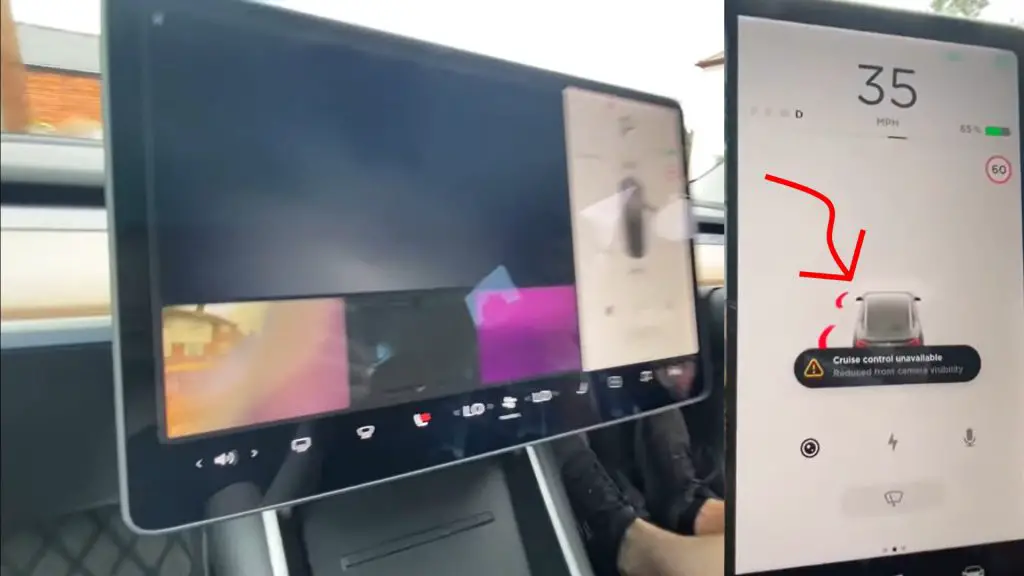Autonomous vehicles are one of the most impressive additions to the automotive industry recently. To think that a small computer fitted inside your car can actually think as you would in driving scenarios is simply amazing. This ‘computer’ is, of course, assisted by cameras and sensors, which act as sensory organs for the car. But what will happen if these sensors and cameras are blocked?

Does Tesla Autopilot Work If You Block All Cameras?
British YouTuber Jack Massey Welsh conducted a small Autopilot test a few months back. He owns a Tesla Model 3. In this test, he decided to cover up all cameras of the Autopilot system one by one and check the resulting problems. Ideally, if camera visibility is reduced, Autopilot should not work. It can cause safety hazards, especially if the detection systems don’t work properly.
Tesla’s Autopilot System
The entire detection system in a Tesla car is quite interesting. It consists of 8 cameras covering 360° of visibility. It allows detection at distances of up to 250 metres. There are twelve updated ultrasonic sensors which detect both hard and soft objects at distances of up to 500 metres. And, there is also a forward-facing radar which is able to detect through a variety of weather conditions.
Why Conduct The Test
The idea behind conducting the test was to check which cameras are more significant for detection in the Autopilot system. There are a total of four major cameras that cover most of the surroundings of the car. There is a rear camera below the Tesla logo on the trunk. Two cameras are present on the sides – one under each side-view mirror. Finally, there is a system of three cameras that covers a broad spectrum in front of the vehicle.
The Actual Test – Some Cameras Blocked
Jack started by covering only the right-side camera. The vehicle still allowed him to drive and use the Autopilot too. A warning popped up later, that said “right side camera blocked or blinded. Clean camera lens for better visibility.” But it did not affect the performance of the Autopilot. There was a small issue though. There was a limit on the detection of cars passing him in the opposite direction. The front-facing camera did detect the forthcoming car when it was approaching. But once it was beside the Tesla, it disappeared from the screen, only to reappear when it was in the range of the rear camera.
Jack went on to cover the left-side camera as well. Apart from the limited detection of cars exactly beside him, there were no issues. The Autopilot performed excellently, slowing down perfectly according to the situation.
He then covered the rear camera and tried reversing towards a pavement. At this point, the detection system started getting affected a little. The car was a little distance away from the pavement, but the sensor was showing fluctuating distances. The Autopilot feature, however, remained unaffected. The only small difference was that it was unable to detect pedestrians. It did detect all cars on the road.
The Actual Test – All Cameras Blocked
Jack then blocked the set of cameras on the front windshield. He used a piece of paper to cover all three cameras at once. But the moment he put the car into drive mode, the car activated the windshield wipers and blew the paper away. After somehow managing to cover the front cameras, the car was put to test. The vehicle was unable to detect objects on the roads. It was still detecting lane markings, but they were quite faint.
This time, however, Jack could not activate the Autopilot. An error kept coming up on the screen. This means that the front-facing set of cameras contribute to most of the detection for the Autopilot system.
Our Opinion
It was interesting to see the Autopilot working even when three out of the four cameras were blocked. This talks about the significance of the front-facing cameras a lot. Secondly, the moment there was a small object detected on the windshield, the wipers ensured that it doesn’t block the camera’s view. This may not be a big thing, but it is a useful tidbit.
The Autopilot is a very important stepping stone for Tesla towards achieving autonomy. The fact that the system can work on just one camera is really good. The use of sensors and cameras is going to increase multifold as autonomous vehicles make their way into the industry. It is good to see that their capability is already strong.
You can watch the video attached below.


















